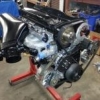Rb25 Coolant Flow / Hose / Swirl Pot / Header Tank Setup
Announcements
-
Similar Content
-
Latest Posts
-
Also, a tip for young players Check the dates on new tyres before they fit them, I always ask this question at the tyre shop, as they have tried to put "new" tyres on one of my cars a few years ago, but the build date was about 3 years old
-
Yeah - 4 or 5 years is the limit for decent tyres. Pedestrian grade tyres with 400 TW ratings start out hard and don't start to suffer until they are somewhat older again. But the stickier decent stuff? Nup. My current ADO9s are < 2 yrs old, 17000km in, only have about the minimum 2mm of tread depth left, and they are.....not what they used to be. They are clearly much harder now than when new. Whether that is heat cycles (unlikely, for a road tyre), different compound between top and bottom of tread, or actually aging out (in less than 2 years!!!) is not really able to be discerned. But I'd credit actual aging as being at least part of the cause. I've got an old pair of ~50% worn AD08Rs in the shed that I really need to get rid of. They started feeling waaaay too hard to put back on the car after a couple of years sitting there.
-
Personally I wouldn't put tyres over 4 or 5 years old on any of my own cars. Once they go hard the grip characteristics completely change. As per most things it only matters in an accident and that's when you most want them to do their job!
-
I'm replacing the front tyres on the E39 tomorrow because one of them has a few gouges out of it. There is so much tread still on them but they're also 9 years old and the rubber is super hard. This falls within the guidelines of 10 years old that I've read which surprises me given their condition. I'm curious about whether you guys care about tyre age or just judge the tyre based on condition? How old would you consider too old?
-
What starts as a scratch, becomes a flesh wound, then quadruple amputation. Jus' sayin'. Crush resistant gloves (The ones with the rubber strips down the back of the hand and fingers) might not be a bad idea after all!
-



.thumb.jpg.0587eb4ad8984ef89760b02271b3381b.jpg)




Recommended Posts
Create an account or sign in to comment
You need to be a member in order to leave a comment
Create an account
Sign up for a new account in our community. It's easy!
Register a new accountSign in
Already have an account? Sign in here.
Sign In Now